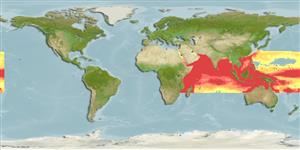Environment / Climate / Range
Ecology
Marine; pelagic-oceanic. Tropical, preferred ?; 30°N - 21°S
Indo-West Pacific: Red Sea, Arabian Sea and the Persian Gulf to South Africa and the Philippines, north to Viet Nam, south to northern Australia (Ref. 9911). This species is noted as a possible synonym of the earlier Mobula diabolus (Shaw, 1804) in Compagno's 1999 checklist (Ref. 35766).
Size / Weight / Age
Maturity: Lm ? range ? - ? cm
Max length : 100.0 cm WD male/unsexed; (Ref. 6871)
Short description
Morphology | Morphometrics
Brownish-grey above, whitish below (Ref. 11228). Underside of pectorals with semicircular black blotch along middle of anterior edge (Ref. 11228).
Found in coastal and oceanic waters (Ref. 30573); solitary of aggregations, sometimes with 50 or more individuals (Ref. 90102). Not known to penetrate the epipelagic zone (Ref. 9911). Feeds on plankton (Ref. 30573). Ovoviviparous (Ref. 50449).
Life cycle and mating behavior
Maturity | Reproduction | Spawning | Eggs | Fecundity | Larvae
Exhibit ovoviparity (aplacental viviparity), with embryos feeding initially on yolk, then receiving additional nourishment from the mother by indirect absorption of uterine fluid enriched with mucus, fat or protein through specialised structures (Ref. 50449).
Compagno, L.J.V., 1999. Checklist of living elasmobranchs. p. 471-498. In W.C. Hamlett (ed.) Sharks, skates, and rays: the biology of elasmobranch fishes. Johns Hopkins University Press, Maryland. (Ref. 35766)
IUCN Red List Status (Ref. 115185)
CITES (Ref. 94142)
Not Evaluated
Threat to humans
Harmless
Human uses
More information
Age/SizeGrowthLength-weightLength-lengthLength-frequenciesMorphometricsMorphologyLarvaeLarval dynamicsRecruitmentAbundance
ReferencesAquacultureAquaculture profileStrainsGeneticsAllele frequenciesHeritabilityDiseasesProcessingMass conversion
Tools
Special reports
Download XML
Internet sources
